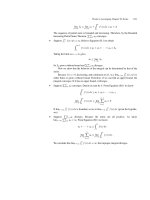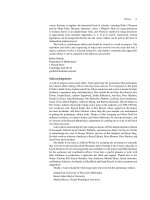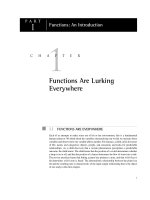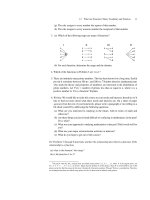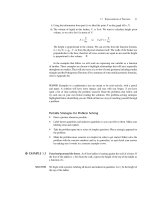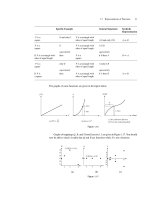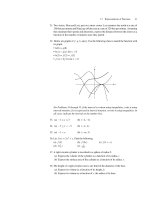Calculus: An Integrated Approach to Functions and their Rates of Change, Preliminary Edition Part 90 pptx
Bạn đang xem bản rút gọn của tài liệu. Xem và tải ngay bản đầy đủ của tài liệu tại đây (138.51 KB, 10 trang )
28.2 Arc Length, Work, and Fluid Pressure: Additional Applications of the Definite Integral 871
amount of work to
lift up the ith slice
≈ (weight of ith slice) · (distance to the top)
The volume of the ith slice =π(4)
2
x = 16πx m
3
.
The density of water is 1000 kg/m
3
. Therefore
the mass of the ith slice = 1000 · 16πx kg.
We calculate the weight of the slice by multiplying by g ≈9.8 m/sec
2
.
The weight of the ith slice ≈ 1000 ·16πx · 9.8 newtons
≈ 156,800πx newtons
amt. of work to lift up the ith slice ≈ 156,800πx · x
i
total work = lim
n→∞
n
i=1
156,800π · x
i
x =
1.5
0.1
156,800πx dx
total work = 156,800π
x
2
2
1.5
0.1
= 156,800π
1.125 − 0.005
= 175,616π
The work done is 175,616π joules, or ≈ 551,713.9 joules.
(b) To reduce the water level to 0.7 m, to pump half the water out, requires partitioning the
interval [0.1, 0.8] into n equal pieces because the water slices must move between 0.1
and 0.8 m.
0.1
0.8
Figure 28.23
0.8
0.1
156,800πx dx = 156,800π
x
2
2
0.8
0.1
= 156,800π[0.32 −0.005]
= 49,392π joules, or ≈ 155,169.5 joules
Notice that it takes substantially less work to reduce the water depth from 1.4 m to 0.7
m than it does to reduce it from 0.7 m to 0 m.
◆
Fluid Pressure and Force
Water is an invaluable resource of the earth, and civilizations have devoted much scientific
energy toward understanding it. We build bridges to travel over it, tunnels to travel under it,
dams to contain it, plumbing, draining, and irrigation systems to direct it, and submarines
to explore its depths. Understanding fluid pressure (force per unit area) is critical to the
success of these projects.
872 CHAPTER 28 More Applications of Integration
The fundamental principle is that fluid pressure is directly proportional to depth and, when
a system is at equilibrium, it is the same in all directions. Pressure =
fluid
density
· (depth).
This means that given a submerged object in an equilbrium state, the fluid pressure
down, the fluid pressure up, and the horizontal fluid pressures on the object are all the same.
The hydrostatic force exerted by a fluid on a plane surface of area A situated horizontally
at a depth d is given by
force = (pressure) · (area) = ρd · A,
where ρ is the density of the liquid, its weight per unit volume.
d
x
x x x x
d d d d
The hydrostatic force on the base of every bottle of water is the same
Figure 28.24
This means that if a bottle whose base has area A is filled with fluid to a height d, the fluid
force on the base is unaffected by the shape of the bottle. (See Figure 28.24.)
NOTE In the metric system, water density is given as 1000 kg/m
3
. To get weight per unit
volume, multiply by g.
water density = (9.8)(1000) = 9800 newtons/m
3
.
In the English system,
water density = 62.4 lbs/ft
3
.
When building a dam or an underwater support for a bridge, the force of the water is
more complicated to calculate because the structure is submerged vertically or at an angle
as opposed to horizontally; the pressure increases with the depth.
◆
EXAMPLE 28.11 Suppose a particular dam has the shape of a parabola 40 feet wide at the top and 50 feet
deep. Calculate the hydrostatic force on the dam when the water level is 5 feet from the top
of the dam.
28.2 Arc Length, Work, and Fluid Pressure: Additional Applications of the Definite Integral 873
SOLUTION We establish a coordinate system as shown in Figure 28.25 and take horizontal slices so
that the depth does not vary much within a slice. Partition [0, 45] into n equal pieces, each
of height y =
45
n
. Let y
i
= iy, for i = 0, 1 , n.
the force on the
ith strip
≈ (water density in lb/ft
3
) ·
depth of
ith strip
·
area of
ith strip
≈
62.4 lbs/ft
3
·
(
45 − y
i
)
ft ·
area of the
ith strip
50
20
45
0
5
Water level
Depth = 45 – y
i
y
i
y
0
y
1
y
n
y
x
(20, 50)
Top of dam
Face of dam
.
.
.
.
Figure 28.25
We can approximate the area of the horizontal slices by treating them as rectangles of height
y and width 2x
i
. To express the width in terms of y we find the equation of the parabola.
(This is where the dimensions of the dam come into play.)
y − kx
2
because we’ve put the vertex of the parabola at the origin.
50 =k(20)
2
⇒ k =
50
400
=
1
8
y =
1
8
x
2
and x =±
8y
Therefore, the area of the ith strip ≈ 2x
i
y = 2
√
8y
i
y = 4
√
2
√
y
i
y ft
2
the force on the ith strip ≈ (62.4 lbs/ft
3
) · (45 − y
i
)ft · 4
√
2
√
y
i
y ft
2
874 CHAPTER 28 More Applications of Integration
total force = lim
n→∞
n
i=1
62.4(45 − y
i
)4
√
2
√
y
i
y
=
45
0
62.4
(45 − y
) 4
√
2
√
ydy
fluid density · depth · area
= 249.6
√
2
45
0
(45y
1/2
− y
3/2
)dy
= 249.6
√
2
45 ·
2
3
y
3/2
−
2
5
y
5/2
45
0
= 249.6
√
2
30 ·45
3/2
−
2
5
· 45
5/2
≈ 1,278,673 lb
◆
There are many other applications of integration. Integrals can arise in physics when
computing moments, centroids, or centers of mass. They can arise in economics when
computing consumer surplus and the present value of an income stream. They arise in
biology when computing blood flow through a blood vessel. Integration is used to calculate
the surface area of a surface of revolution. It is used extensively in statistics and probability.
This is not an exhaustive list!
Pick an application of integration that interests you and learn about it. You have the
basic tools you need in order to understand the exposition. You might try to read about it
from a few sources—for instance, a calculus textbook and a book in the relevant discipline.
PROBLEMS FOR SECTION 28.2
1. Using the arc length formula, find the length of the line f(x)= mx + b from x = 0to
x = 3. Confirm that this answer agrees with the distance formula.
In Problems 2 through 4, approximate each length with error less than 0.05.
2. The length of one arc of the cosine curve, say from x =
−π
2
to x =
π
2
3. The length of f(x)=x
2
from x =−1tox = 1
4. The length of y = ln x from x = 1tox = e
5. Find the work done in pushing a stroller 200 feet along a path by applying a constant
force of 12 pounds in the direction of motion.
6. A force of 5 pounds will stretch a certain spring 3 inches beyond its natural length.
(a) What is the value of the spring constant?
(b) How much work is done in stretching the spring from its natural length to 3 inches
beyond its natural length?
28.2 Arc Length, Work, and Fluid Pressure: Additional Applications of the Definite Integral 875
(c) How much work is done in stretching the spring from 3 inches beyond its natural
length to 6 inches beyond its natural length?
(d) Why is the answer to part (c) larger than the answer to part (b)?
7. Suppose 1.2 foot-pounds of work are required to compress a spring 2 inches.
(a) How much work is required to stretch this spring 2 inches from its equilibrium
position?
(b) How much work is required to stretch this spring 4 inches from equilibrium?
(c) How much work is required to stretch the spring 5 inches from its equilibrium
position?
8. A window washer weighing 160 pounds is attached to a rope hanging from the roof of
the building whose windows he is washing. The rope weighs 0.6 lb/ft. Right now he is
working 50 feet down from the rooftop.
(a) How much work is required to bring him to the windows that are 25 feet from the
rooftop?
(b) How much work will it take to bring him from where he is to the roof?
9. Amelia and Beulah are city dwellers who have set up pulley systems to get their
groceries delivered without walking the stairs. Amelia pulls her basket filled with 12
pounds of groceries up to her 40-foot-high balcony. Beulah pulls her basket filled with
16 pounds of cleaning supplies up to her 30-foot-high window. Assuming both women
use ropes weighing 0.2 lb/ft, whose task requires more work? How much more work?
(Assume friction is negligible.)
10. A rectangular swimming pool is 4 feet deep, 75 feet long, and 25 feet wide. It is
completely filled with water.
(a) What is the hydrostatic force on the bottom of the pool?
(b) What is the hydrostatic force on the shorter wall of the pool?
(c) What is the hydrostatic force on the longer wall of the pool?
(d) How much work is required to pump all the water out of the pool (i.e., up to the
top of the pool)?
11. A hemispherical tank with a radius of 7 feet is filled to a height of 6 feet with gasoline.
How much work is required to pump all the gasoline over the top? The weight-density
of gasoline is 42 lb/ft
3
.
7 ft
6 ft
7 ft
Hemispherical tank
12. As part of the pasteurization and homogenization process, milk is stored in a large tank
as shown on the following page.
876 CHAPTER 28 More Applications of Integration
3 ft
5 ft
Semicircular cross-section
The next step in the processing requires the milk to be pumped out of this holding
tank. If the tank is filled to the brim, how much work is required to empty it? The
weight-density of milk is 64.5 lb/ft
3
.
13. Refer to Problem 12. What is the force exerted by the milk on the semicircular side
wall of the holding tank?
14. A dam in a canyon has the shape of an isosceles triangle. Its depth is 30 feet and its
width is 15 feet. The water level is 2 feet below the top of the dam. What is the total
hydrostatic force on the face of the dam?
15
30 ft
Face of the dam
15. A dam has the shape of an isosceles trapezoid. It is 40 feet deep. Its base is 30 feet
long while on the surface it measures 60 feet across. (Its thickness is irrelevant to the
problem.) If the water reaches the top of the dam, what is the total hydrostatic force on
the face of the dam?
16. Project Pick an application of integration not explicitly discussed in this text and learn
about it. Then either write an exposition of the application or prepare a short lesson on
it. Include examples.
29
CHAPTER
Computing Integrals
In this chapter we introduce techniques of integration that expand our computational ability.
Section 29.1 presents integration by parts, the integration analogue of the Product Rule. Sec-
tions 29.2 and 29.3 introduce methods of transforming a difficult integrand into something
more manageable. In the final section of this chapter we expand our notion of integration
to encompass unbounded integrands and/or an unbounded interval of integration.
29.1
INTEGRATION BY PARTS—THE PRODUCT RULE
IN REVERSE
Integration by parts is a method of integration derived from the Product Rule for differ-
entiation. This technique will help us evaluate integrals such as
x sin xdx,
xe
x
dx,
x ln xdx,
ln xdx, and
tan
−1
xdx. It is a useful technique for integrands involving
the product of different types of functions as well as those involving a single intractable
function, and it is a powerful tool for transforming an integral.
The Product Rule tells us that if f and g are differentiable functions, then
d
dx
(
f(x)g(x)
)
= f(x)g
(x) + g(x)f
(x).
Let’s denote f(x)by u and g(x) by v. Then, using the differential notation introduced in
the substitution section, we can write
du = f
(x) dx and dv = g
(x) dx.
The Product Rule becomes
877
878 CHAPTER 29 Computing Integrals
d(uv) = udv+ v du.
d(uv) =
udv+
v du
uv =
udv+
v du
This can be rearranged to give what is referred to as the formula for integration by parts.
Integration by parts:
udv= uv −
v du
This formula expresses the original integral in terms of an expression involving a new
integral. Our aim is to arrive at a new integral that is easier to compute than the original.
Given an integral
h(x) dx, the general idea is to choose u and dv such that
h(x) dv =
udv and
we can find v =
dv,
du is simpler than u, and
v du is simpler (or no more difficult) than
udv.
Indefinite Integrals Using Integration by Parts
◆
EXAMPLE 29.1 Find
xe
x
dx.
SOLUTION
Let u = x, dv =e
x
dx
Then du = dx, v=
e
x
dx = e
x
.
x
u
e
x
dx
dv
= x
u
e
x
v
−
e
x
v
dx
du
= xe
x
− e
x
+ C
REMARKS
1. Notice that we wrote v =
e
x
dx =e
x
, a particular antiderivative of e
x
, as opposed to
e
x
+C, the family of antiderivatives. Try letting v =e
x
+C
1
and verify that the answer
remains the same. In Exercise 29.1 you’ll verify that choosing any one antiderivative
always suffices.
2. Suppose we try the following.
Let u = e
x
, dv = xdx
du = e
x
dx, v =
x
2
2
.
We obtain
xe
x
dx = e
x
x
2
2
−
1
2
x
2
e
x
dx.
29.1 Integration by Parts—The Product Rule in Reverse 879
This new integral is more complex than the original integral, indicating a poor choice
of u and dv. (Notice that these choices do not conform to the guidelines set out on the
previous page.)
3. Given
xe
x
dx, we would like to get rid of the “extra x.” Integration by parts is a
mechanism that essentially allows us to do that.
◆
EXERCISE 29.1 Show that replacing v by v + C in the formula for integration by parts does not alter the
result. (You will end up getting uC − uC.)
◆
EXAMPLE 29.2 Find
x ln xdx.
SOLUTION
Let u = ln x, dv = xdx
du =
1
x
dx, v =
x
2
2
.
x ln xdx=
ln x
u
· xdx
dv
= (ln x) ·
x
2
2
−
1
2
x
2
·
1
x
dx
=
1
2
x
2
ln x −
1
2
xdx
=
1
2
x
2
ln x −
1
4
x
2
+ C
REMARK Both x and ln x become “simpler” when differentiated, but we choose u =ln x
because x is much easier to integrate than ln x.
◆
◆
EXAMPLE 29.3 Find
ln xdx.
SOLUTION
Let u = ln x, dv = dx
du =
1
x
dx, v = x.
ln xdx= x ln x −
x ·
1
x
dx
= x ln x −
1 dx
= x ln x − x + C
REMARK Notice that in this example the entire integrand is denoted by u. The approach
when finding
tan
−1
dx or
sin
−1
dx or
(ln x)
2
dx is similar. Integration by parts is
amazingly effective in transforming these difficult integrals into simple ones.
◆
Repeated Use of Integration by Parts
Sometimes we have to use integration by parts multiple times. As long as the new integrals
that arise are not more difficult than the original we may be on the right track.
880 CHAPTER 29 Computing Integrals
◆
EXAMPLE 29.4 Find
x
2
e
x
dx.
SOLUTION
Let u = x
2
, dv = e
x
dx
du = 2xdx, v = e
x
.
x
2
e
x
dx = x
2
e
x
−
e
x
· 2xdx
= x
2
e
x
− 2
xe
x
dx
The integral
xe
x
dx can be done by using integration by parts, as shown in Example 29.1.
Therefore,
x
2
e
x
dx = x
2
e
x
− 2(xe
x
− e
x
) + C (by Example 29.1)
= x
2
e
x
− 2xe
x
+ 2e
x
+ C
= e
x
(x
2
− 2x + 2) + C.
REMARKS
1. When doing integration by parts multiple times it is easy to make sign errors. Be
cautious—use parentheses.
2. Sometimes you may end up with a constant of −2C,
1
3
C, etc. You may replace −2C
by C
1
. Sometimes −2C is simply replaced by C because C is an arbitrary constant.
3. To find
x
4
e
x
dx we would do integration by parts four times. ◆
EXERCISE 29.2 Use integration by parts to derive the reduction formula
x
n
e
ax
dx =
1
a
x
n
e
ax
−
n
a
x
n−1
e
ax
dx
where a and n are non-zero constants.
In the following example we use integration by parts twice, but the resulting integral is
no simpler than the original. In fact, it is the same. You may at first think that we’ve gotten
nowhere, but watch how we can solve algebraically for the integral in question.
◆
EXAMPLE 29.5 Find
e
2x
sin 3xdx.
SOLUTION
Let u = e
2x
, dv = sin 3xdx
du = 2e
2x
dx, v =−
1
3
cos 3xdx.
e
2x
sin 3xdx=−
1
3
e
2x
cos 3x −
−
1
3
cos 3x
· 2e
2x
dx
=−
1
3
e
2x
cos 3x +
2
3
e
2x
cos 3xdx
